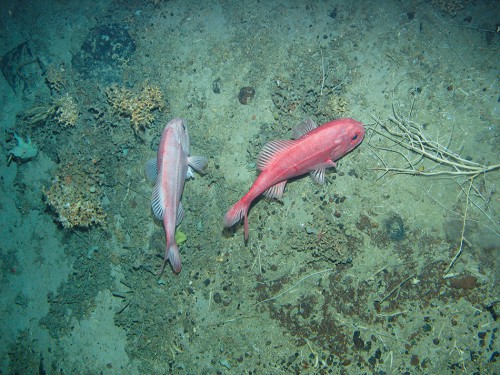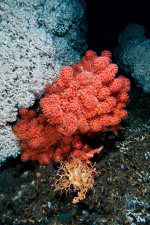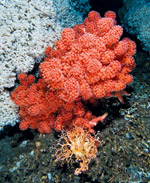
The deep sea – remote and endangered
Fishing in the dark
The assertion that the moon has been more thoroughly researched than the deep sea is still true. The deep sea refers to the totally dark layers of the ocean below around 800 metres.
Submersible robotic vehicles that can penetrate to the deepest parts of the ocean, the deep-sea trenches, have been in use for some time, but expeditions with these are expensive and complex. So our knowledge of life at great depths is still fragmentary. At best, submersible vehicles provide only highlights in the vast darkness, and sea-floor samples obtained with grab samplers or trawls deployed from research ships allow only isolated snapshots of the deep-sea ecosystems.
Although the impact of human encroachment on these systems is largely unknown, the deep ocean regions have been fished since the end of the Second World War. At first, fishing mostly targeted species of Sebastes, at depths of only a few hundred metres. Now fish are being caught from depths around 2000 metres, where the living conditions are fundamentally different from those in shallow regions. The Food and Agriculture Organization of the United Nations (FAO) defines deep-sea fisheries as those conducted between the depths of 200 and 2000 metres.
Flourishing life in the darkness
Off northwest Europe the transition from land to the sea bottom is a gradual slope. Off the coast lies a sprawling continental shelf. The North Sea is situated here as a shallow, offshore marginal sea. A similar situation is found off the coast of China with the South China Sea. The wide continental shelf ends at the break to the continental slope, which falls more steeply to greater depths. There are also coasts, however, where the transition from the land to deep sea is more abrupt. Here the wide continental shelves and marginal seas are absent. An example of this is the coast of Japan, where the sea floor descends abruptly and steeply into the depths.
Distinctive structures rise from the sea floor all around the world: submarine banks, ridges and seamounts. A bank is defined as a sea-floor elevation that can be several hundred kilometres long or wide. Banks are composed of sandy material or massive rock.
The kind of fish that predominate in an area depends in part on the bottom characteristics. Individual fish species have different modes of life. Some live close to the bottom. They are demersal. Other species swim in the open water column and are called pelagic. There are also species that live near the bottom, but rise into the water column to hunt for food. These are benthopelagic species.
It is amazing that special biological communities have developed in the deep sea in spite of the darkness. Most of them have only been superficially investigated and biologists are constantly discovering new species that have not yet been described. In recent years researchers have been focussing on cold-water corals in particular, as well as the ecosystems around seamounts and at deep-sea hydrothermal vents and cold seeps. The great biological diversity discovered here was completely unexpected because the deep sea had long been considered to be a dead and muddy desert. The species diversity in the deep sea was sensational for researchers.
Seamounts
Seamounts are underwater mountains that are formed by volcanic activity and rise at least 1000 metres above the sea floor. Some are 3000 or even 4000 metres high. Their peaks often rise up into the upper layers of the mesopelagic zone. Seamounts can be regarded as islands or volcanoes that do not reach up to the sea surface. It was long believed that these were rare occurrences. Today it is known that seamounts are present in all oceans. The total number is estimated in the thousands.
Research has shown that some seamounts are home to communities of unique, endemic species. These include lower animals like sponges and sea cucumbers, relatives of the starfish, but also vertebrates such as fish, which can occur in large schools around seamounts with high species diversity. This makes the seamounts especially interesting for fisheries.
- 3.14 > Seamounts are commonly located at volcanic structures such as the ocean ridges, and sometimes form long chains along the sea floor. Seamounts with a height between 1000 and 3000 metres are marked in red, those higher than 3000 metres in blue.
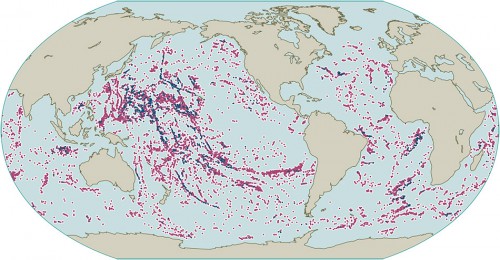
- There are still many unanswered questions regarding the significance of seamounts. Many scientists believe that seamounts act like gigantic stirring rods in the ocean, where small-scale eddies break off from the large ocean currents. It is presumed that nutrients and dead plant and animal remains from the epipelagic are trapped in these eddies and attract fish. That would be a logical explanation for the high diversity at seamounts and the sometimes very high fish densities. It is also known that migratory birds on their transoceanic flights and large predatory fish like sharks commonly hunt and feed in marine regions with seamounts.
Furthermore, sharks apparently use seamounts as geomagnetic orientation points and sometimes mate there in large groups. Elsewhere, bigeye tuna may converge to hunt among the dense schools of prey fish. An example of this hunting is seen in eddies over the Hawaiian seamounts.
Cold-water corals
Corals usually evoke a mental picture of idyllic South Sea Islands, white palm beaches and swarms of colourful luminescent fish darting through clear waters suffused with light. Actually, however, some coral species also live in cold, deep water layers. They occur primarily in the Atlantic, off the coast of Norway or northwest of Ireland, but they are also found in the Pacific near Australia and New Zealand. It has been known for centuries that there are corals living in deeper waters because fishermen have often found pieces of them in their nets. Until 20 years ago, however, no one had any idea of the areal extent of cold-water coral reefs. While searching for an ideal route for a pipeline in 1982, workers for the Norwegian energy company Statoil discovered large populations of the cold-water coral Lophelia pertusa. The underwater photographs caused a sensation at the time.
- Today it is known that the Norwegian coral reef has an area of around 2000 square kilometres and, in terms of size, exceeds even the warm-water coral reefs in the diving grounds of the Seychelles. A great number of rare and even unique species live on the Norwegian coral reef. Furthermore, these reefs serve as a nursery ground for fish, providing an effective retreat and protection area for the offspring. The term “cold-water coral” does not refer to a particular species. It includes around 1000 species that thrive in cold water at temperatures between 4 and 12 degrees Celsius. Many of them occur in the mesopelagic zone between 200 and 400 metres of water depth. Some species, such as the Antarctic deep-sea coral Flabellum impensum, can live at depths down to 2000 metres – at a water temperature of around 1 degree Celsius.
Reefs
Reefs are narrow, elongated elevations on the sea floor. Coral reefs are composed of the carbonate skeletons of corals, which have built up to form reefs several metres high over thousands of years. Mussels can also build reefs. In addition, there are reef-like sand banks and rocky reefs.Hydrothermal vents and cold seeps on the sea floor
Hydrothermal vents on the sea floor are found primarily in regions of volcanic activity, most commonly in areas where continental plates drift apart. Mid-ocean ridges have formed at these plate boundaries over thousands of years as fresh magma continuously rises from the Earth’s interior. They have built up over time to form high mountain chains thousands of kilometres long. Water seeps 2 to 3 kilometres down into the Earth’s crust through fractures and cracks in the rocks and is heated by the magma chambers. Because the heated liquid has a lower density, it rises again. At some locations minerals stain the water black. For this reason the vents are also called black smokers. The minerals are an elixir for bacteria, primary producers that generate biomass. Experts refer to this process as chemosynthesis, an allusion to the photosynthesis carried out in sunlight. The bacterial biomass provides the foundation for higher life forms. The black smoker sites are also populated by shrimp, fan-shaped gorgonian corals, or tube worms.
Exclusive economic zone
The Exclusive Economic Zone (EEZ) is also referred to as the 200-nautical-mile zone. Here, coastal states have sovereign rights to the explora-tion and exploitation of living and non-living resources. This includes the exclusive use of fish stocks in one’s own EEZ. Furthermore, within its own EEZ a state may erect offshore drilling rigs or wind farms- Today there are around 300 known black smoker sites worldwide. Most of them are in the Pacific. There are, however, almost no commercially important fish species living in these extreme habitats. It has only been known for a few years that cold seeps in the deep sea are special and important habitats. Cold nutrient-rich water flows out of the sea floor here.
During an expedition off the coast of Pakistan in 2007 scientists discovered densely populated cold seeps. There are mussel banks, crabs, snails and sea cucumbers. Although experts had long known about heavily populated cold seeps in the Gulf of Mexico, they were believed to be an exceptional case. Actually, however, cold seeps are found in numerous ocean regions. Off the coast of Pakistan, for example, the Arabian continental plate is being pushed beneath the Eurasian plate. In the process, water contained in the sediments is pressed out. It flows back into the ocean through fissures in the bottom. Substances contained in the water provide nutrition for bacteria and small animals, which in turn become food for higher organisms such as crustaceans.
The fish of the deep sea
In the nutrient-rich and highly productive coastal regions, massive reproduction is typical of many species, and this ensures their survival. Many deep-sea fish species, on the other hand, are characterized by slow growth, late sexual maturity, long life, and the production of fewer offspring. They are adapted to life at great depths, to a habitat in which unchanging environmental conditions prevail. The strong temperature fluctuations that can impact the reproduction of fish in shallow coastal regions are absent here. However, the deep sea is not as rich in nutrients as the coastal waters. The carrying capacity is almost exhausted and competition for food is great. Most species have therefore adapted by producing fewer, but highly competitive offspring. This reproduction strategy is called K-strategy (K refers to the carrying capacity of the environment). There is a high parental investment in the offspring. The eggs of many deep-sea fish are relatively large and rich in nutrients so that the larvae have a good chance of developing well.
- 3.16 > Many fish species of interest to fisheries occur in the deep water layers. Some do not reach sexual maturity until a relatively late age.
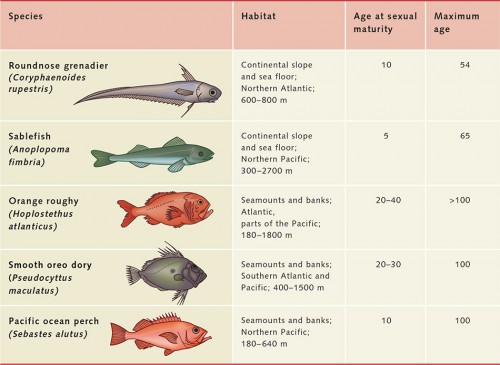
- One example of this is the deep-sea orange roughy (Hoplostethus atlanticus), which does not reach sexual maturity until the age of around 25 and can live to be 125 years old. The orange roughy lives at seamounts and builds up very large stocks over time. These fish grow slowly and can survive periods of scarce food supply. Furthermore, thanks to the long life expectancy of the individual fish, the stock can compensate for times of low offspring production. Fish species of the K-strategy type are especially threatened by deep-sea fisheries. When the older fish are continuously removed by fishing, at some point there will be too few sexually mature animals remaining to sustain the population.
However, not all fish living in the deep sea are K-strategists. The blue whiting (Micromesistius poutassou), for example, occurs on the continental slopes at depths from 100 to 1000 metres. It is, however, a species that produces great numbers of offspring. The reason for this is that the immature fish spend most of their time in the shallow shelf areas in water depths around 100 metres, where there are numerous predators and food competitors. Massive reproduction is therefore the ideal strategy for the blue whiting.
High seas
The “high seas” are the areas of the ocean to which all states have free access. No country may claim sovereignty over any part of the high seas. The high seas, where freedom of naviga-tion, research and fishery are internationally recognized, begin at the boundary of the 200-nautical-mile zone. Much of the deep-sea region lies outside the EEZ, and is therefore part of the high seas. All nations have the right to exploit fish stocks there.Fisheries in the deep sea
Commercial fishing has only been carried out in deep waters over the past few decades. Although longline fishing has been practised since the 18th century, industrial fishing far out in the ocean first became practicable in the 1950s with the availability of seaworthy refrigeration ships. Deep-sea fishing received a boost in the early 1970s with the introduction of the 200-nautical-mile zone, or Exclusive Economic Zone, which made it impossible for foreign ships to fish close to the coasts of another country. The high seas, including the deep sea, were an alternative fishing area. The Soviet Union and Japan in particular were soon specializing in the deep-sea regions. In the beginning the catch amounts were enormous – especially around structures such as seamounts and banks.
To the extent that fish stocks were gradually shrinking in the coastal areas, deep-sea fishing became increasingly interesting for other countries as well. According to a survey by the FAO, there were 27 countries conducting deep-sea fishing in the year 2008, with Spain, South Korea, New Zealand and Russia at the forefront. Around 70 per cent of the ships employ trawl nets, and these are often demersal-trawl nets. Today these can be deployed to a depth of 2000 metres.
- It soon became obvious that deep-sea fishing is problematic in two respects. For one, valuable habitats such as cold-water corals or the ecosystems at seamounts are destroyed when nets come in contact with the bottom. Secondly, fish species are quickly decimated, particularly the K-strategists. For example, newly discovered stocks of orange roughy were reduced to 15 to 30 per cent of their original size within just 5 to 10 years. In many areas the species was commercially depleted. This “boom and bust” kind of fishery is typical in the pursuit of deep-sea fish species. The reason for this is that species like the orange roughy not only produce a small number of offspring, their reproductive performance is also very erratic and episodic. Several years can pass with low production of offspring before a strong season occurs again. It is still not known what controls or triggers these fluctuations. Investigations at the Great Meteor Seamount west of Madeira have indicated an influence of changes in the winds affecting eddy currents above the seamount.
- It is a certainty that the deep-sea species cannot compensate for heavy fishing activity. Deep-sea fishing is also both ecologically and economically questionable. For one thing, it is very destructive, and for another the catch levels are relatively low because most deep-sea fish stocks are comparatively small due to their K-strategy. Thus, taken as a whole, the deep-sea fisheries represent only a small proportion of the worldwide catch amounts. Basically they can only be maintained because of the high subsidies, since the costs for fuel are high for the great distances ships often have to cruise out.
- 3.18 > The catches of many deep-sea fish, like the orange roughy shown here, declined rapidly within just a few years because of overfishing.
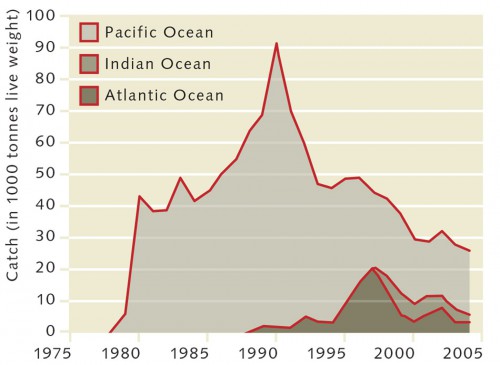
- 3.19 > Over the years, the total catches of deep-sea fisheries have remained high. However, this was only possible because new species have replaced the overfished stocks of other species. The figure shows the total amounts for different species in each year. An example of overfishing of a deep-sea species is provided by the armourhead, which had been fished by Japanese and Russian trawlers at Pacific seamounts since the 1960s. Within 10 years the stocks were so strongly reduced that the species was commercially depleted and abandoned by fisheries.
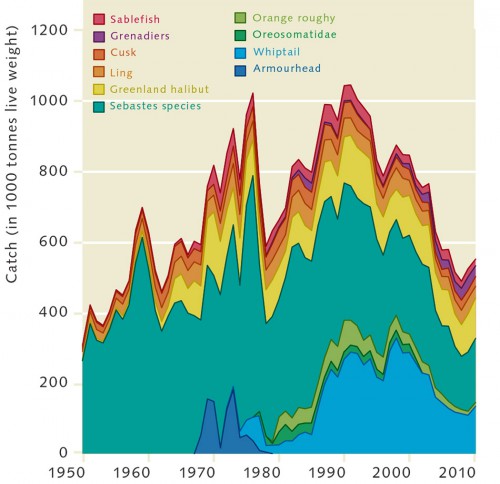 Again and again over the years, new species that previously were not considered by fisheries have become interesting, usually to replace species that were overfished. The pursuit of various species of Sebastes is a striking example of the substitution of an overfished species by a new one. The total catch has dropped since the 1970s, but it has still remained at a comparatively high level. This has been possible because new species have been targeted.
Again and again over the years, new species that previously were not considered by fisheries have become interesting, usually to replace species that were overfished. The pursuit of various species of Sebastes is a striking example of the substitution of an overfished species by a new one. The total catch has dropped since the 1970s, but it has still remained at a comparatively high level. This has been possible because new species have been targeted.
In the northeast Atlantic, starting in the 1950s, Sebastes marinus (golden redfish) was initially caught. In 1980 it still made up more than 40 per cent of the catch of Sebastes species. But then the stocks declined. In the 1990s Sebastes marinus made up less than 20 per cent of the total catch of Sebastes species in the northeast Atlantic. In lieu of Sebastes marinus, fishing of the Greenland stocks of Sebastes mentella (deepwater redfish) intensified. In this region the species is mainly demersal. As these Greenland stocks shrank, the focus shifted to the more pelagic-living Sebastes mentella stocks in the open Atlantic. Due to restraints on fishing, it has been possible for some time now for the Sebastes mentella stocks off Greenland to recover.
- 3.20 > In Norway’s Trondheimsfjord the red bubble gum coral (Paragorgia arborea) occurs beside the white stony coral Lophelia pertusa. There are around 1000 cold-water coral species worldwide.
Destruction of unique habitats
Many species of deep-sea fish build up large stocks, especially at structures like seamounts, banks and cold-water coral reefs. Fishing for these species represents a potential threat to the environment, especially when demersal trawls are used that can destroy fragile corals. The problem is that corals grow very slowly, usually only a few millimetres each year. So it can take decades for the habitats to recover. Studies at several neighbouring seamounts off Tasmania have shown that 43 per cent of the species were previously unknown and thus could be unique. In areas where demersal trawls were used, the total number of species was diminished to 59 per cent of the original number. 95 per cent of the surface was reduced to bare, stony bedrock. It is thus highly conceivable that endemic species that only exist at a single seamount could be completely exterminated.Is it possible to protect the deep sea?
In 2008, in response to the growing knowledge that deep-sea habitats are especially threatened by fisheries, the FAO established the International Guidelines for the Management of Deep-sea Fisheries in the High Seas. These guidelines are not legally binding. They do, however, contain clear recommendations for the protection of fish species that are vulnerable to overfishing. They relate to methods by which the fishing gear comes into contact with the sea floor. These guidelines, by definition, should regulate protection in international waters outside the Exclusive Economic Zone (EEZ), where freedom of the seas and fishing is recognized.
- 3.23 > Rockall, off Ireland. At its base is a marine area considered to be one of the most species-rich and deserving of protection in the northeast Atlantic.
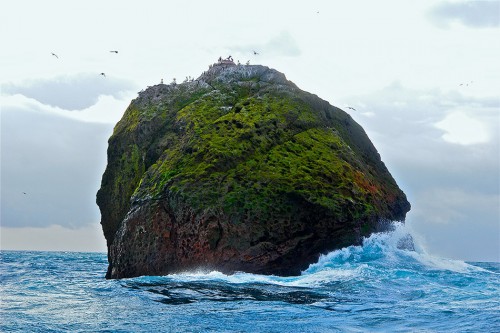
- The FAO refers to areas deserving protection as vulnerable marine ecosystems (VMEs). In addition to banks, seamounts and cold-water coral areas, these include large species-rich sponge communities as well as densely populated undersea hydrothermal vents and cold seeps. The following criteria are used to determine whether a marine area is given the status of a VME:
1. UNIQUENESS OR RARITY:
Ecosystems that are unique or contain rare species. The loss of the ecosystem cannot be compensated for by similar ecosystems. These include: habitats with endemic species, habitats with endangered species, breeding or spawning areas.2. FUNCTIONAL SIGNIFICANCE:
Habitats that are important for the survival, reproduction or recovery of fish stocks, or are significant for rare or threatened species, or various development stages of these species.3. FRAGILITY:
An ecosystem that is highly susceptible to destruction or weakening by anthropogenic activities.4. SIGNIFICANCE FOR SPECIES WITH SPECIAL LIFE-HISTORY TRAITS:
Ecosystems that are characterized by species or assemblages with the following traits: slow growth rates, late sexual maturity, low or unpredictable reproduction, long-lived.5. STRUCTURAL COMPLEXITY:
An ecosystem that is characterized by complex structures, for example, by corals or isolated rock outcrops. Many organisms are specially adapted to these structures. Such ecosystems often have high diversity.
- The designation of an international marine area as a vulnerable marine ecosystem according to the FAO guidelines is decided, as a rule, by the Regional Fisheries Management Organizations (RFMOs). It is the task of the RFMOs to apportion the catch of fish stocks or individuals of migrating species such as tuna in their area among the member countries. In addition, they are responsible for ensuring that the protection measures and catch limits are complied with. RFMOs develop management plans and announce sanctions in cases of non-compliance. Critics claim that many fish stocks in areas managed by the RFMOs are still not fished with sufficient restraint, and that vulnerable areas are not adequately protected. A number of regional fisheries management organizations have now placed certain VMEs within their areas under special protection, particularly those at several seamounts off southwest Africa. Fishing is either completely banned there or demersal trawl fishing is prohibited. Pelagic fish that swim in the upper water layers may still be fished. Fishing for demersal species, however, which live near the bottom, is halted. There are other protected areas with VMEs northwest of Ireland, including Hatton Bank and the Rockall Bank, which is several hundred kilometres long. Here the responsible RFMO has established Marine Protected Areas (MPAs), whose primary objective is to protect overfished stocks. The relatively small vulnerable marine ecosystems are located within these much larger MPAs. Demersal trawl fishing has been banned here to protect the cold-water corals.
Species and genus A species is design-ated by a two-part name. The first part (for example, Sebastes) indicates the genus. Usually many closely related species belong to one genus. The second part indicates the species (marinus). Although species can often be very similar to one another, such as, in birds, the blue tit and great tit, they still remain clearly sepa-rated, either by a large distance (conti-nent) or because they no longer interbreed. Around 100 species belong to the genus Sebastes.
- Incidentally, one of the first protected areas in VME terms was established long before the FAO published its guidelines. In 1995, after the publication of studies on the devastating effects of demersal trawl fishing at seamounts, the Australian government established a deep-sea protected area of 370 square kilometres on the continental slope off Tasmania. There are 15 seamounts here and large stocks of orange roughy. The objective was to protect slow-reproducing fish species as well as their vulnerable habitats on the sea floor. The Australian officials only allow fishing down to a depth of 500 metres. This should prevent the overfishing of deep-sea fish and the fragile bottom from net contact. With this decision the Australian officials were more than 10 years ahead of their time and the FAO guidelines. On the other hand, in the region south of Tasmania there are a total of 70 seamounts and only 15 are protected. The question of whether the protected area is large and representative enough to preserve all of the species indigenous to the Tasmanian seamount region is still being discussed today.
The FAO guidelines for deep-sea fishing on the high seas were developed to protect vulnerable habitats in international waters. Of course, they also apply to equivalent deep-sea areas inside national waters that fulfil the criteria for a VME. In this respect, the guidelines are also an important orientation point for the countries themselves. Many nation-states have now designated valuable areas as VMEs and placed them under special protection. Norway, for example, protects parts of its cold-water coral regions in this way. Critics claim, however, that the extent of these areas is far from sufficient to preserve the full diversity of the cold-water coral systems.

